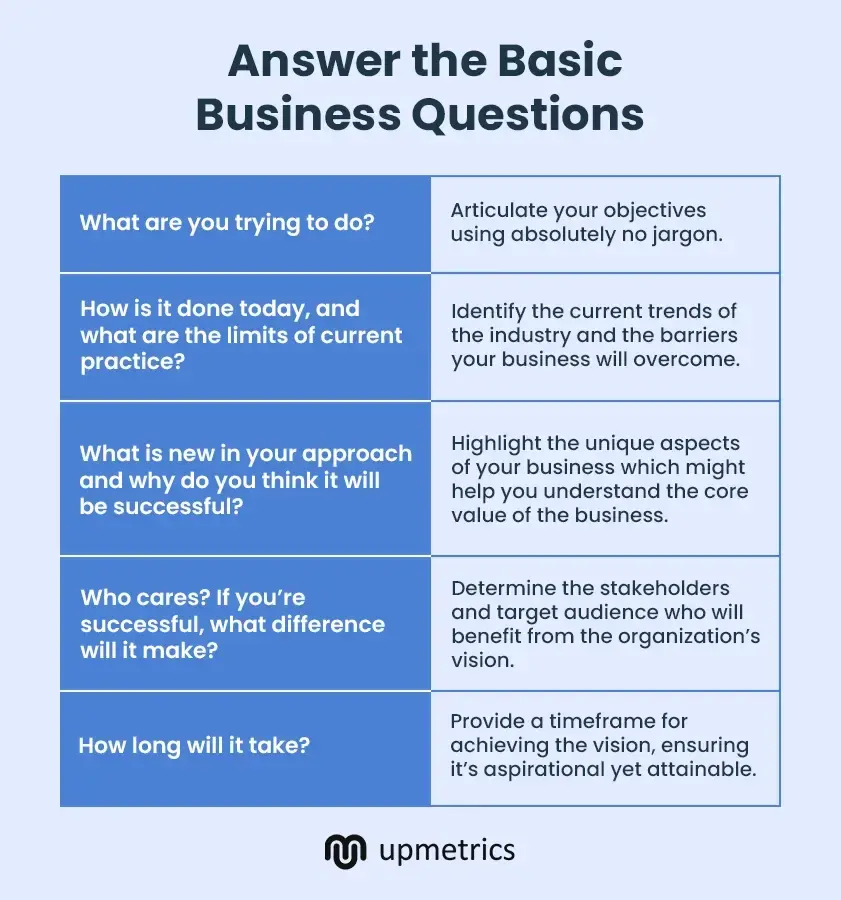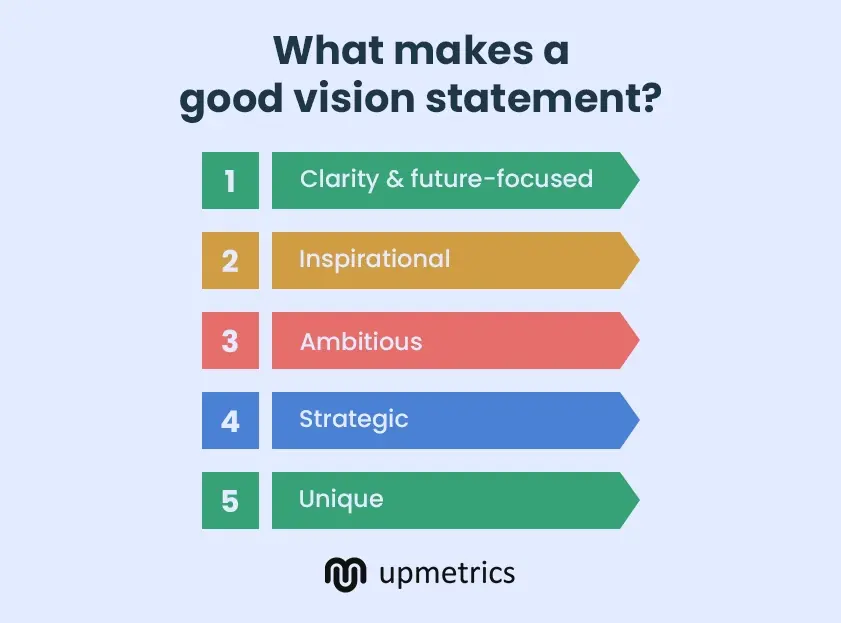There is a famous quote by Simon Sinek “People don’t buy what you do, people buy why you do it.” This quote forces you to think deeply about the core purpose of your business.
Moreover, crafting a compelling vision statement helps you find and communicate this purpose.
By clearly stating why your business exists or what it aims to achieve in the future, you can create a shared vision for your customers and employees.
So ready to learn to write a vision statement for your business? Let’s get started.
What is a vision statement?
A vision statement is a clear, concise description of what an organization aims to achieve in the long term. It captures the essence of the organization’s future goals and serves as a guide for its growth and decision-making.
The statement focuses on the future and inspires and directs employees and stakeholders. It also highlights the desired impact the organization seeks to make in the world.
Why is a vision statement important?
Companies often combine their mission and vision statements into one. While as common as it is, it’s not advisable.
Because, a clear vision statement keeps a company focused and aligned, connecting everyone—investors and employees toward a common goal.
It helps in boosting employee engagement, making them more focused and productive. Vision statements also help you make strategic decisions, supporting the business to stay on track.
A good vision statement also outlines the business’s future goals, encouraging innovation and creativity as employees search for new ways to achieve them.

How to write a vision statement for your business plan?
A strong vision statement outlines your long-term goals, providing a clear direction for the future. Let’s see how to draft it:
1. Understand the purpose
The first step in crafting your vision statement is to understand the core purpose of the business. It involves diving into the mission of your business—thinking about the problem you solve, the need you fulfill, and the value you bring.
You can even merge the perspectives of the whole team, as Alfred Christ, a Digital Marketer, did for Robotime, to get the actual essence of the business.
“We engaged individuals from various departments to get an all-rounded outlook on what we stand for and where we want to go. Through this collaborative approach, we were able to capture the essence of our brand in such a way that everyone in the company could relate to it and strive towards,” says Alfred.
Knowing the core purpose of your business will help bring authenticity to the vision statement.
2. Start with the list of keywords
Next up, form a cloud of keywords that can reflect your business as well as trigger some emotion in your audience. Ultimately, you want to create sentences using those keywords to make an impact while promoting your business, its idea and purpose. And yes, you should also include your target audience.
For instance, we talked to Abhi Madan, Creative Director of Amarra, a high-end evening-wear fashion brand, discussing how they used this strategy for their vision statement, and he said,
“We made sure that our vision statement wasn’t just about what we do (creating enchanting attire), but also about how we make our customers feel (empowered, confident, and graceful).”
Besides that, keywords guide brainstorming sessions, providing a starting point for discussions and helping to generate ideas.
3. Answer the basic business questions
You can use Heilmeier Catechism to write a vision statement. It’s a set of questions that helps one consider and assess proposed research programs, determining if they’re worth the risk.

Let’s see how the questions can help:
- What are you trying to do? Articulate your objectives using absolutely no jargon.
- How is it done today, and what are the limits of current practice? Identify the current trends of the industry and the barriers your business will overcome.
- What is new in your approach and why do you think it will be successful? Highlight the unique aspects of your business that might help you understand its core value.
- Who cares? If you’re successful, what difference will it make? Determine the stakeholders and target audience who will benefit from the organization’s vision.
- How long will it take? Provide a timeframe for achieving the vision, ensuring it’s aspirational yet attainable.
Remarkably, by using these questions, you can craft a vision statement that clearly defines the organization’s long-term goals, unique approach, and potential impact while addressing challenges and the timeframe for success. Told you, it’ll help!
4. Envision the future
Imagine your company after five or ten years—capture that dream for your business and the success you envision in the vision statement.
It should inspire employees and stakeholders to work towards the common goal. It also differentiates your brand from other competitors.
For example, Microsoft’s vision statement is “To help people and businesses worldwide realize their full potential.” This vision statement is future-focused as it emphasizes the long-term goal of empowering individuals and organizations globally.
5. Write your vision first in long-form
Now, you’ve got keywords and the future goal for your business. It’s time for you to write the long form of your vision statement.
Writing your vision first in long-form helps you clearly outline your organization’s future goals and aspirations. This detailed approach allows you to capture all the essential details and the impact you want to make.
By starting with the long-form description, you ensure nothing important is missed when you later shorten it into a concise vision statement.
6. Make it short & evaluate
Once you have an extended version of your vision statement, take a few days and revisit it with a fresh perspective.
Evaluate the lengthy vision statement first. See if it makes sense or is ambitious enough. Then, identify the key points or ideas that sum up your business’s essence.
Done? Now, it’s time to review and shorten. Remove any redundancies or non-essential information to maintain clarity. Ensure that the shortened vision reflects your core values and aligns with your long-term aspirations.
Generally, the vision statement is one to two sentences long. So, keep the length in mind.
7. Review and revise
Once you’ve written your vision statement, reviewing and revising it to ensure its effectiveness is crucial.
Start by gathering employee, stakeholder, and customer feedback to get diverse perspectives. Assess the impact of the statement—consider whether it’s inspiring and motivating for your team and stakeholders.
Revise the statement based on feedback and assessments, and repeat the review process until it resonates well. Regular reviews help ensure the vision statement remains aligned with the organization’s mission and strategy.
What makes a good vision statement?
A good vision statement possesses several essential qualities that ensure it’s effective. Some of the qualities are:

Clarity & future-focused
It should be clear and easy to understand, avoiding jargon or complex language. Also, it should paint a picture of what the organization aspires to achieve in the long term, providing a clear direction.
Inspirational
A vision statement should inspire employees, stakeholders, and customers. A good vision statement should evoke a sense of purpose and drive people to work towards a common goal.
Ambitious
A great vision statement conveys a sense of passion for the future the company is working for. While it should challenge the organization, it must also be attainable to maintain credibility and drive progress.
Strategic
Don’t try to cram every service or every detail of your business into your vision statement. Even in conversation with Mark Pierce—Founder and CEO of Wyoming Trust & LLC Attorney, he mentioned facing the same problem. He says:
“I faced the challenge of summarizing our multiple services and finally framed vision as: ‘To provide affordable, high-quality legal services that safeguard family assets and legacy,’ by focusing on the core issues our clients care about.”
Unique
The statement should highlight what makes the organization special and different from competitors. A good vision statement should reflect the unique aspects of the business’s identity.
Vision statement examples of popular brands
A well-written vision statement showcases the future goals of your business. Here are some examples of well-crafted vision statements by famous companies:
1. Tesla
“To create the most compelling car company of the 21st century by driving the world’s transition to electric vehicles.”
This vision statement emphasizes leadership in the industry through sustainable energy solutions.
2. Google
“To provide access to the world’s information in one click.”
The clearly articulated statement focuses on making information easily accessible and universally useful.
3. Apple
“To make the best products on earth and to leave the world better than we found it.”
It combines a commitment to quality with environmental responsibility.
4. Coca-Cola
“To craft the brands and choice of drinks that people love, to refresh them in body & spirit.”
This vision statement is as refreshing as the drink! It focuses on creating beloved brands and refreshing beverages that uplift people.
5. Intel
“If it is smart and connected, it is best with Intel.”
Very smart way of Intel telling us that it’s the leader in technology solutions—today and tomorrow.
6. LinkedIn
“To create economic opportunity for every member of the global workforce.”
This vision statement aims to provide career opportunities and professional growth for everyone.
7. Samsung
“Inspire the world, create the future.”
This statement focuses on innovation and inspires progress through technology.
8. BMW
“To be the world’s leading provider of premium products and premium services for individual mobility.”
BMW’s vision statement emphasizes leadership in the luxury automotive market with top-tier products and services.
9. Sony
“Using our unlimited passion for technology, content, and services to deliver groundbreaking new excitement and entertainment, as only Sony can.”
It emphasizes Sony’s commitment to innovation and excellence in technology and entertainment, delivering unique experiences.
10. IKEA
“To create a better everyday life for the many people.”
This vision focuses on improving everyday living by offering affordable and well-designed home furnishings.
Conclusion
In summary, a vision statement paints a picture of your company’s future and aligns it with your core values. We hope this guide has helped you write your vision statement!
However, after crafting your vision statement, incorporating it into a comprehensive business plan is also crucial for your business.
Upmetrics can help make creating your business plan easier. With it, you can streamline the planning process and develop a well-structured plan that supports your vision.
So why wait? Try Upmetrics today.

